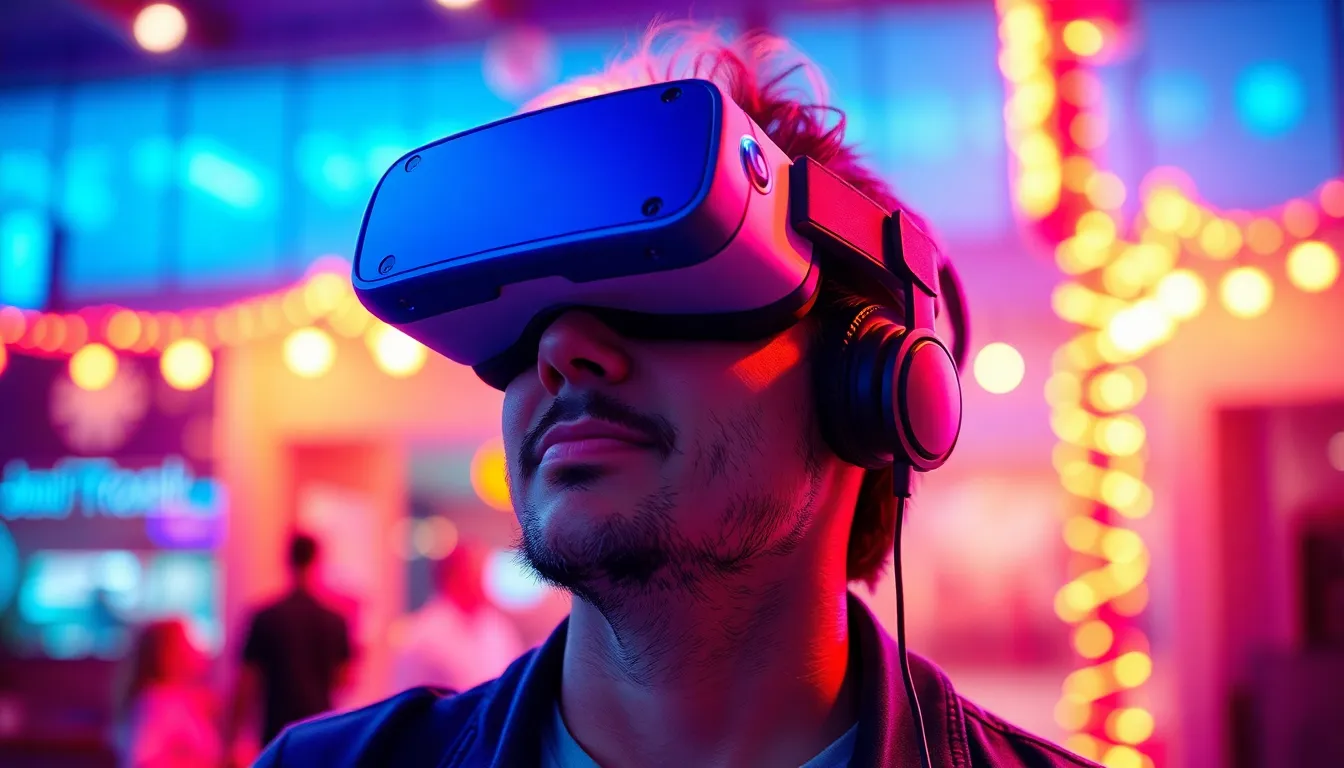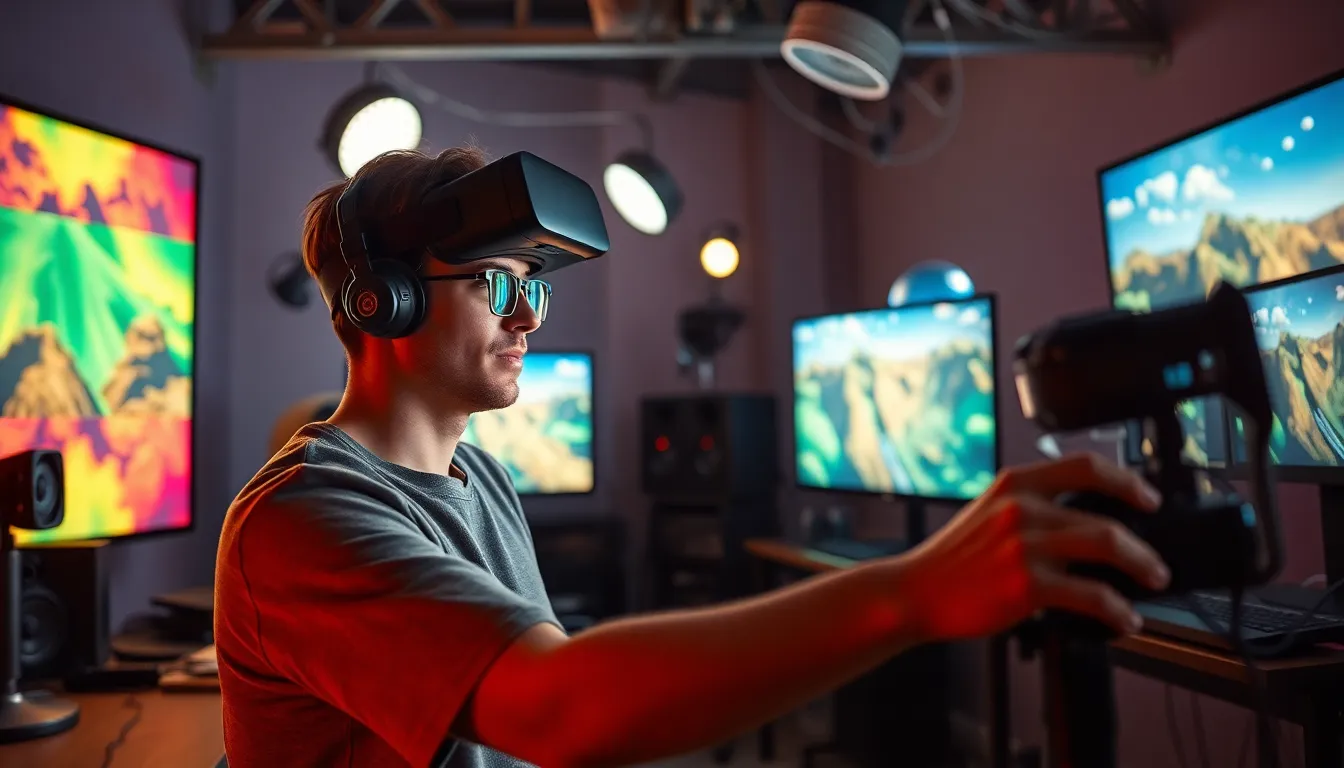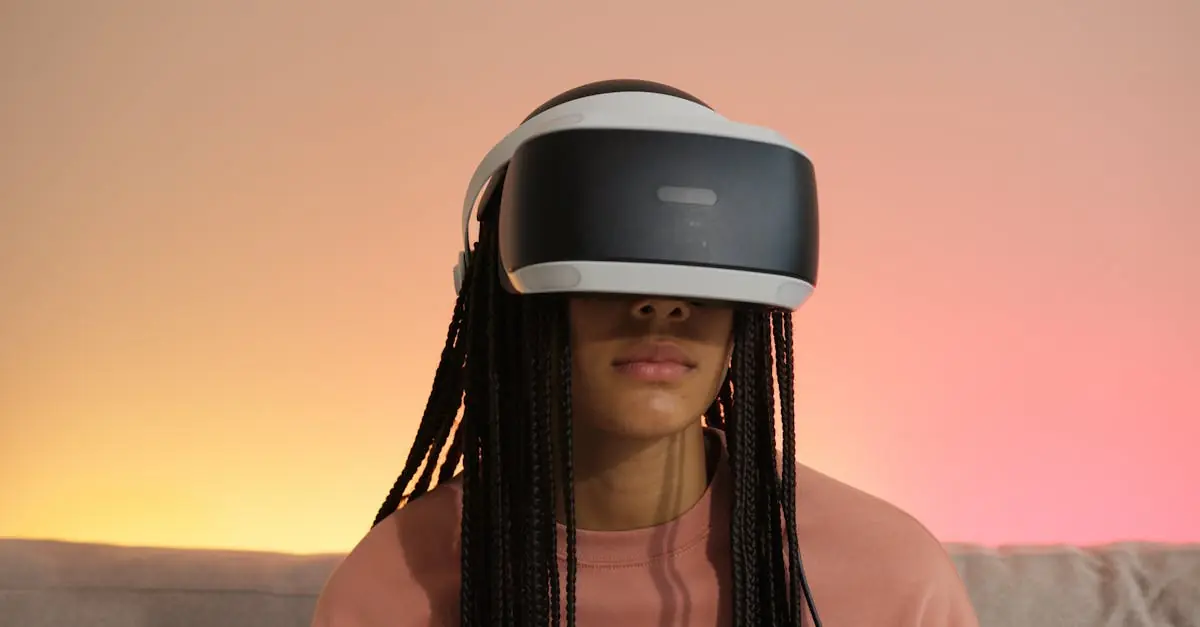Imagine stepping into a world where the sun sets just for you, shadows dance like they’re auditioning for a Broadway show, and every flicker of light feels like a warm hug. Welcome to the mesmerizing realm of VR cinematic lighting. This isn’t just about making things look pretty; it’s about crafting immersive experiences that pull viewers right into the heart of the action.
Table of Contents
ToggleOverview of VR Cinematic Lighting
VR cinematic lighting plays a crucial role in shaping immersive experiences. This technology enhances the mood and tone of virtual scenes, allowing viewers to connect more deeply with narratives. By manipulating light sources, artists create atmospheres that evoke specific emotions in audiences.
Realistic shadows strengthen the credibility of virtual environments. They provide vital cues about depth and object placement, enriching the overall experience. Brightness levels also contribute significantly, influencing how viewers perceive content. High contrast can create tension, while softer lighting promotes calmness.
Color temperature affects emotional reactions as well. Warmer tones often evoke feelings of comfort, while cooler hues can instill a sense of unease. Iconic films frequently use these techniques, guiding audience emotions through visual storytelling.
Dynamic lighting further elevates the experience in VR. This allows for changes in light intensity or color during scenes, reflecting shifts in action or mood. Such variability captures viewers’ attention and keeps them engaged throughout their experience.
Incorporating environmental lighting extends immersion as well. Natural elements like sunlight and moonlight convey realism, while artificial sources like neon lights can set futuristic or urban vibes. Each element works together to build a cohesive narrative.
Attention to detail in VR cinematic lighting makes it essential for developers. It goes beyond mere decoration; it actively enhances the viewer’s journey through the virtual realm. By exploring how lighting techniques impact storytelling, creators can deliver unforgettable experiences.
Importance of Lighting in VR

Lighting serves as a crucial element in virtual reality experiences. It shapes how viewers interact with and perceive the virtual environment.
Enhancing Immersion
Immersive experiences rely heavily on realistic lighting. Proper illumination allows viewers to feel as if they are part of the scene. Shadows inform audiences of object placement, creating visual depth. Bright lighting naturally attracts attention while dim areas invite exploration. Dynamic changes in lighting can mirror emotional shifts, helping users connect with the narrative. When adjusted thoughtfully, light can transform mundane spaces into engaging landscapes. This meticulous attention to lighting ultimately heightens the overall immersion.
Creating Atmosphere
Atmosphere emerges from the interplay of light and color. Warm lighting often conveys comfort, inviting viewers to linger. Conversely, cooler tones can introduce tension or unease, enhancing dramatic moments. Bright contrasts generate excitement, while softer hues foster tranquility. Variations in light intensity can emphasize particular actions or themes, shaping audience responses. Artists leverage environmental lighting to mimic real-world scenarios, further anchoring users in the experience. Each choice in lighting design contributes significantly to the overarching mood.
Techniques in VR Cinematic Lighting
Techniques in VR cinematic lighting significantly enhance visual engagement and emotional connection. Artists utilize various methods to create immersive environments.
Dynamic Lighting Approaches
Dynamic lighting approaches allow for real-time adjustments within virtual scenes. Artists can manipulate light intensity and color, responding to narrative shifts. Techniques like keyframe animation enable light changes to sync seamlessly with story progression. Real-time rendering provides flexibility, letting creators modify lighting on the fly. Such adaptability leads to more engaging viewer experiences, reflecting emotional changes in the narrative.
Color Grading and Mood
Color grading plays a crucial role in establishing mood within VR environments. Different hues impact emotions, with warmer tones often creating comfort. Cooler shades, on the other hand, evoke tension or unease. Artists adjust color balance to highlight key elements and guide audience perception. Specific color palettes can reinforce themes, helping to immerse viewers further into the story’s emotional landscape. Choices in color grading effectively influence how audiences connect with the narrative on a deeper level.
Tools and Software for VR Cinematic Lighting
Various tools and software enhance VR cinematic lighting, enabling artists to craft immersive experiences.
Popular Lighting Engines
Popular engines such as Unreal Engine and Unity offer powerful tools for creating stunning virtual environments. Unreal Engine excels in providing real-time rendering capabilities and photorealistic lighting, making it a favorite among developers. Unity, on the other hand, supports various lighting techniques, including baked and real-time lighting, ensuring versatility for different projects. Developers frequently use these engines to manipulate dynamic lighting and shadows, enhancing overall realism. Both platforms also integrate seamlessly with virtual reality headsets, optimizing experiences for users.
Plugins and Enhancements
Plugins like Bakery and Amplify Shader Editor significantly enhance lighting workflows. Bakery provides advanced light baking features, enabling efficient scene optimization without sacrificing quality. Amplify Shader Editor allows designers to create complex shaders and lighting effects, offering full control over visual aesthetics. These extensions cater to various needs, streamlining processes and increasing productivity. Many artists find that utilizing plugins leads to more polished and visually engaging results, ultimately enriching the viewer’s experience.
Challenges in VR Cinematic Lighting
VR cinematic lighting presents unique challenges that can impact the overall experience. Artists often encounter difficulties in achieving realistic lighting under varying conditions. Creating a cohesive atmosphere requires careful consideration of multiple elements, including shadow density and color temperature.
Durability plays a vital role during real-time rendering. Maintaining performance without sacrificing visual fidelity proves challenging, especially in complex scenes with dynamic lighting. Viewers expect seamless transitions, yet too many light sources can result in performance issues.
Another challenge lies in viewer perception. Diverse hardware, from high-end VR systems to mobile devices, affects how lighting is rendered. Ensuring consistent quality across platforms requires significant effort in optimization.
Artistic intent also meets technical constraints. Balancing creativity with the limitations of software and hardware can be frustrating. Artists often struggle to realize their vision within the operational boundaries set by tools like Unreal Engine and Unity.
Dynamic lighting adds a further layer of complexity. Adjusting light intensity and color in real-time demands precision and robust algorithms. The risk of overwhelming the viewer with rapid changes increases significantly if not handled with care.
Interaction between light and environmental elements raises additional questions. Managing reflections and refractions accurately is essential for realism. Each incremental adjustment impacts how viewers experience immersion.
Finally, emotional connection depends on effective lighting choices. Crafting the right mood requires thoughtful manipulation of brightness and color palettes. Artists must remain aware of how these elements resonate emotionally with audiences.
VR cinematic lighting stands as a pivotal element in the realm of immersive storytelling. Its ability to shape emotions and enhance viewer engagement cannot be overstated. By expertly manipulating light, artists create environments that resonate on a deeper level, drawing audiences into the narrative.
The techniques and tools available for crafting these lighting experiences continue to evolve, offering new opportunities for creativity. However, the challenges of achieving realism while maintaining performance remain significant. As artists refine their approaches, the impact of lighting in virtual reality will only grow, leading to richer emotional connections and unforgettable experiences. The future of VR cinematic lighting promises to elevate storytelling to new heights.


